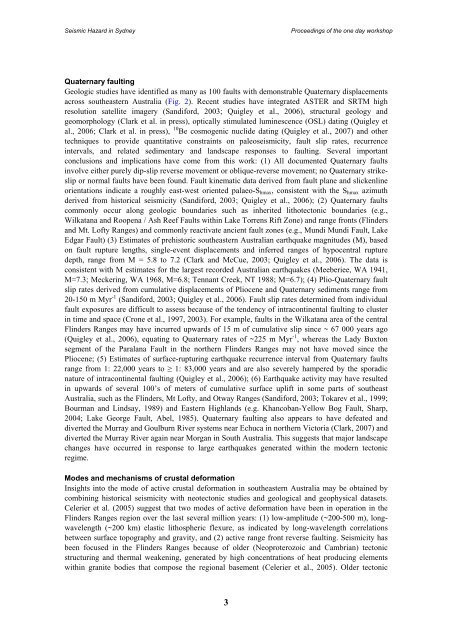Landslides in the Sydney Basin - Geoscience Australia
Landslides in the Sydney Basin - Geoscience Australia
Landslides in the Sydney Basin - Geoscience Australia
- No tags were found...
Create successful ePaper yourself
Turn your PDF publications into a flip-book with our unique Google optimized e-Paper software.
Seismic Hazard <strong>in</strong> <strong>Sydney</strong>Proceed<strong>in</strong>gs of <strong>the</strong> one day workshopQuaternary fault<strong>in</strong>gGeologic studies have identified as many as 100 faults with demonstrable Quaternary displacementsacross sou<strong>the</strong>astern <strong>Australia</strong> (Fig. 2). Recent studies have <strong>in</strong>tegrated ASTER and SRTM highresolution satellite imagery (Sandiford, 2003; Quigley et al., 2006), structural geology andgeomorphology (Clark et al. <strong>in</strong> press), optically stimulated lum<strong>in</strong>escence (OSL) dat<strong>in</strong>g (Quigley etal., 2006; Clark et al. <strong>in</strong> press), 10 Be cosmogenic nuclide dat<strong>in</strong>g (Quigley et al., 2007) and o<strong>the</strong>rtechniques to provide quantitative constra<strong>in</strong>ts on paleoseismicity, fault slip rates, recurrence<strong>in</strong>tervals, and related sedimentary and landscape responses to fault<strong>in</strong>g. Several importantconclusions and implications have come from this work: (1) All documented Quaternary faults<strong>in</strong>volve ei<strong>the</strong>r purely dip-slip reverse movement or oblique-reverse movement; no Quaternary strikeslipor normal faults have been found. Fault k<strong>in</strong>ematic data derived from fault plane and slickenl<strong>in</strong>eorientations <strong>in</strong>dicate a roughly east-west oriented palaeo-S hmax , consistent with <strong>the</strong> S hmax azimuthderived from historical seismicity (Sandiford, 2003; Quigley et al., 2006); (2) Quaternary faultscommonly occur along geologic boundaries such as <strong>in</strong>herited lithotectonic boundaries (e.g.,Wilkatana and Roopena / Ash Reef Faults with<strong>in</strong> Lake Torrens Rift Zone) and range fronts (Fl<strong>in</strong>dersand Mt. Lofty Ranges) and commonly reactivate ancient fault zones (e.g., Mundi Mundi Fault, LakeEdgar Fault) (3) Estimates of prehistoric sou<strong>the</strong>astern <strong>Australia</strong>n earthquake magnitudes (M), basedon fault rupture lengths, s<strong>in</strong>gle-event displacements and <strong>in</strong>ferred ranges of hypocentral rupturedepth, range from M = 5.8 to 7.2 (Clark and McCue, 2003; Quigley et al., 2006). The data isconsistent with M estimates for <strong>the</strong> largest recorded <strong>Australia</strong>n earthquakes (Meeberiee, WA 1941,M=7.3; Mecker<strong>in</strong>g, WA 1968, M=6.8; Tennant Creek, NT 1988; M=6.7); (4) Plio-Quaternary faultslip rates derived from cumulative displacements of Pliocene and Quaternary sediments range from20-150 m Myr -1 (Sandiford, 2003; Quigley et al., 2006). Fault slip rates determ<strong>in</strong>ed from <strong>in</strong>dividualfault exposures are difficult to assess because of <strong>the</strong> tendency of <strong>in</strong>tracont<strong>in</strong>ental fault<strong>in</strong>g to cluster<strong>in</strong> time and space (Crone et al., 1997, 2003). For example, faults <strong>in</strong> <strong>the</strong> Wilkatana area of <strong>the</strong> centralFl<strong>in</strong>ders Ranges may have <strong>in</strong>curred upwards of 15 m of cumulative slip s<strong>in</strong>ce ~ 67 000 years ago(Quigley et al., 2006), equat<strong>in</strong>g to Quaternary rates of ~225 m Myr -1 , whereas <strong>the</strong> Lady Buxtonsegment of <strong>the</strong> Paralana Fault <strong>in</strong> <strong>the</strong> nor<strong>the</strong>rn Fl<strong>in</strong>ders Ranges may not have moved s<strong>in</strong>ce <strong>the</strong>Pliocene; (5) Estimates of surface-ruptur<strong>in</strong>g earthquake recurrence <strong>in</strong>terval from Quaternary faultsrange from 1: 22,000 years to ≥ 1: 83,000 years and are also severely hampered by <strong>the</strong> sporadicnature of <strong>in</strong>tracont<strong>in</strong>ental fault<strong>in</strong>g (Quigley et al., 2006); (6) Earthquake activity may have resulted<strong>in</strong> upwards of several 100’s of meters of cumulative surface uplift <strong>in</strong> some parts of sou<strong>the</strong>ast<strong>Australia</strong>, such as <strong>the</strong> Fl<strong>in</strong>ders, Mt Lofty, and Otway Ranges (Sandiford, 2003; Tokarev et al., 1999;Bourman and L<strong>in</strong>dsay, 1989) and Eastern Highlands (e.g. Khancoban-Yellow Bog Fault, Sharp,2004; Lake George Fault, Abel, 1985). Quaternary fault<strong>in</strong>g also appears to have defeated anddiverted <strong>the</strong> Murray and Goulburn River systems near Echuca <strong>in</strong> nor<strong>the</strong>rn Victoria (Clark, 2007) anddiverted <strong>the</strong> Murray River aga<strong>in</strong> near Morgan <strong>in</strong> South <strong>Australia</strong>. This suggests that major landscapechanges have occurred <strong>in</strong> response to large earthquakes generated with<strong>in</strong> <strong>the</strong> modern tectonicregime.Modes and mechanisms of crustal deformationInsights <strong>in</strong>to <strong>the</strong> mode of active crustal deformation <strong>in</strong> sou<strong>the</strong>astern <strong>Australia</strong> may be obta<strong>in</strong>ed bycomb<strong>in</strong><strong>in</strong>g historical seismicity with neotectonic studies and geological and geophysical datasets.Celerier et al. (2005) suggest that two modes of active deformation have been <strong>in</strong> operation <strong>in</strong> <strong>the</strong>Fl<strong>in</strong>ders Ranges region over <strong>the</strong> last several million years: (1) low-amplitude (~200-500 m), longwavelength(~200 km) elastic lithospheric flexure, as <strong>in</strong>dicated by long-wavelength correlationsbetween surface topography and gravity, and (2) active range front reverse fault<strong>in</strong>g. Seismicity hasbeen focused <strong>in</strong> <strong>the</strong> Fl<strong>in</strong>ders Ranges because of older (Neoproterozoic and Cambrian) tectonicstructur<strong>in</strong>g and <strong>the</strong>rmal weaken<strong>in</strong>g, generated by high concentrations of heat produc<strong>in</strong>g elementswith<strong>in</strong> granite bodies that compose <strong>the</strong> regional basement (Celerier et al., 2005). Older tectonic3
















